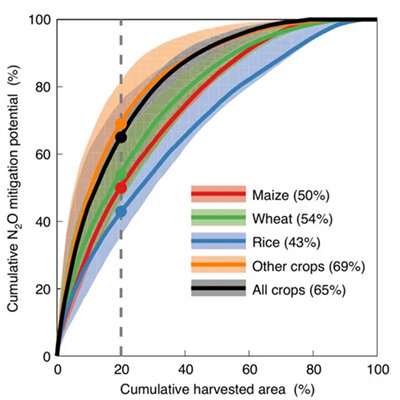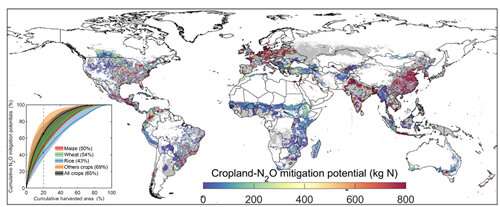Credit: Peking University
Agricultural soils are the largest anthropogenic emission source of nitrous oxide (N2O)—a greenhouse gas 300 times more powerful than carbon dioxide. Mitigating N2O emissions from agricultural soils is an important requirement to stop global warming below the 2°C target. An international team of researchers led by Dr. Zhou Feng from Peking University produced detailed high-resolution maps of global cropland N2O emissions that is published today in Nature Food, revealing large geographic differences explained not only by the amount of N-fertilizer applied by farmers but also by local climate and soil characteristics. The researchers further analyzed where emissions could be reduced by lowering fertilizers applications without compromising the amount of food produced. They found that targeting only 20 percent of the global harvested areas, where excessive fertilizer application prevails, could achieve 65 percent of the global mitigation potential.
"Our study is the first to take a detailed regional perspective at climate change mitigation by reducing cropland N2O emissions. It shed lights on previously hidden environmental and management-related conditions that cause hot-spots of emissions in some regions of the globe" explains Zhou Feng, the study's lead author.
The research team conducted their analysis by combining N input reduction data with global compilation of field observations of emission factors, that is, the amount of emissions per unit of N-fertilizer applied to the crops. Most commonly, countries use one single global emissions factor to estimate their N2O emissions. However, using Artificial Intelligence with vast amount of data collected on emissions factors, crop types, local climates, soil variables and key management practices, the study found emissions factors to vary by up to 100-fold between different regions.
With the new acquired high precision capacity to estimate N2O emissions, the authors were able to identify hotspots of N2O emissions with the largest opportunities of mitigation. These regions were mainly located in humid subtropical and temperate oceanic climates, including the North China Plain, Ganges river basin, Indus river basin, and western Europe.
Credit: Peking University
"We expected that nitrogen fertilizers application rates would be the most important driver of regional differences of emission factors, as found in previous studies, but in fact, we found that climate and soil factors emerged as key influential factors explaining why some regions have higher emissions factors than others, which results into N2O emissions hotspots" explains Cui Xiaoqing, a postdoctoral fellow in Zhou's lab and first author of the study. Management practices probably remains an important driver of emissions at smaller scales, such as a farm, but they could partly offset each other in controlling emission factors.
Philippe Ciais, a coauthor from Laboratoire des Sciences du Climat et de l'Environnement in France, underscores that "the global N2O mitigation potential that could be unlocked by targeting N-fertilizer input reductions without compromising crop production is huge. It amounts to 30 percent of direct soil N2O emissions, equivalent to the current cropland soils emissions of both China and the United States. Two thirds of this mitigation potential could be achieved by reducing fertilizers over only 20 percent of the global area of croplands, especially in humid subtropical farming regions."
"This new study will refocus the world's attention to where the biggest and most efficient opportunities are for nitrous oxide mitigation, and serve as guidance for policy makers to support the reduction of emissions of such a powerful gas as a contribution towards the net zero emission goal of the Paris Agreement" adds Josep Canadell, chief scientist in the Climate Science Center at the Australia-based Commonwealth Scientific and Industrial Research Organisation.
Francesco Tubiello, a senior statistician and team leader for Agri-Environmental Statistics in the Food and Agriculture Organization of the United Nations, adds, "These findings show the value of a science-based approach targeted on global hotspots that could deliver the largest N2O mitigation with large environmental benefits while ensuring no negative consequences for food security. The data-driven approach is also very useful to the assessment and monitoring of sustainable agri-food system."
More information: Xiaoqing Cui et al, Global mapping of crop-specific emission factors highlights hotspots of nitrous oxide mitigation, Nature Food (2021). DOI: 10.1038/s43016-021-00384-9
Journal information: Nature Food
Provided by Peking University
























